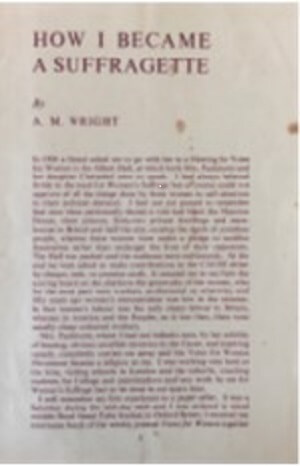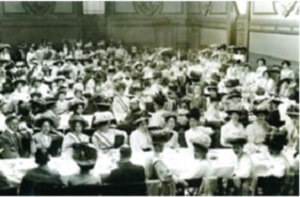Alice Margaret Wright (1880-1961) How I Became a Suffragette

Alice Margaret Wright was a pillar of the community in Chesham Bois for 36 years. A formidable, retired high-school teacher of independent means, she lived a comfortable life at her home Macrea, Stubbs Wood, before moving to 112 Chestnut Lane in 1959. Few would have guessed that she had been jailed as a common criminal in Holloway Prison in 1911. We only know this because just before her death in Chesham Hospital, Margaret wrote a memoir How I Became a Suffragette which is in the museum’s Chiltern Club of Arts collection. It is a gleeful account of her days as a militant campaigner. The Chiltern Club of Arts was founded by Margaret’s friend, and fellow suffrage campaigner, Louise Jopling. Margaret was the secretary of the Club of Arts from 1928 until 1936.
Born in Boston, Lincolnshire, she was the daughter of a successful Unitarian businessman. She was well educated and trained to be a teacher. She moved to London to teach at Channing School in Highgate. In her memoir she explained how in 1908 she heard Mrs Pankhurst speak and immediately enlisted in the WSPU. She wrote of Mrs Pankhurst, “her nobility of bearing, obvious unselfish devotion to the Cause, and inspiring speech, completely carried me away and the Votes for Women Movement became a religion to me.”

Margaret’s experience as a suffragette was typical. She started selling newspapers which was not for the faint hearted. Then she started speaking at rallies, which she practised religiously standing on a chair in her kitchen. She must have been good at it as she was sent all over the country. Of course, this could be dangerous. Memorably at Hampstead, she was greeted by a rowdy crowd and her platform pushed into pond. After witnessing this, a man in the crowd wrote to her, “You must be the pluckiest woman I ever saw to speak as you did to the vast crowd who to all appearances were all against you – I feel your young lives are in danger at the game you are playing”.
Margaret was arrested in November 1910 when Emmeline Pankhurst orchestrated a mass protest targeting cabinet ministers’ houses. She was sent to Lord Harcourt’s house (he was Secretary of State for the Colonies) to throw stones through his window. Despite “not being at the stone throwing stage yet” she succeeded in getting arrested. At the police station she used the name Margaret Left as “my relatives objected strongly to my activities”. Her aunts were both members of our Mid Bucks Suffragists and may well have disapproved of her militancy. They were Alice Pilley of Sonamarg, Little Kingshill and Florence Wright, who accompanied Mary Curtois on the caravan tour in 1914.

As Margaret explained in her memoirs, she was “sentenced to fourteen days in the second division for ‘Loose and disorderly conduct and stone-throwing’. The “loose” amused me for I was respectability personified!” In the second division she was not entitled to receive any visits or correspondence from family or friends as she was serving a sentence of less than one month. She was stripped of her own clothes and all her personal belongings. Instead, she had to wear a green serge dress with a white cap and a check apron all branded with broad arrows. She would have also been provided with rough underwear, coarse shapeless stockings, without garters and ill fitting, mismatched, heavy shoes. She wore a yellow badge showing details of her block and was only known by her cell number until her release. Holloway Prison would have been a wretched experience in January as there was no heating, the lavatory facilities were totally inadequate, and it was infested with mice.
However, her status as a suffragette would have increased after her prison experience. Medals of honour were awarded by the WSPU with prisoners receiving a silver badge depicting a prison gate and chains. A welcome party was arranged at Kilburn Athenaeum, on her release, which would have been a sumptuous affair. At this event she spoke about her experience in prison and shared the platform with her hero, Emmeline Pankhurst.

